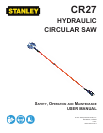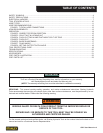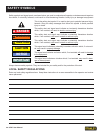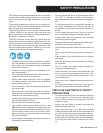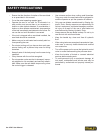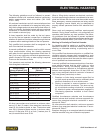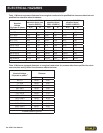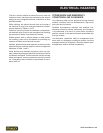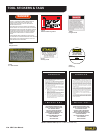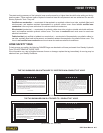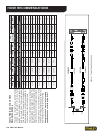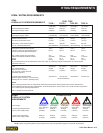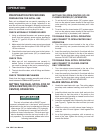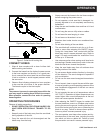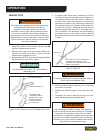
CR27 User Manual ◄ 7
ELECTRICAL HAZARDS
When a lifting device contacts an electrical conductor,
the truck supporting the device is considered to be ener-
gized and contact with the truck must be avoided except
when emergency rescue procedures are being carried
out. Emergency rescue should only be attempted by
properly trained personnel familiar with electrical haz-
ards.
Storm work and emergency conditions create special
hazards. During these conditions, only authorized tool
operators shall perform any tree operation.The follow-
ing guidelines must be followed to prevent accidental
contact with overhead electrical conductors and/or com-
munication wires and cables. (Ref. ANSI Z133.1-2000)
Working in Proximity to Electrical Hazards:
An inspection shall be made by a qualied arborist to
determine whether an electrical hazard exists before
climbing, or otherwise entering, or performing work in
or on a tree.
Only qualied line-clearance arborists or qualied line-
clearance arborist trainees shall be assigned to work
where an electrical hazard exists. Qualied line-clear-
ance arborist trainees shall be under the direct supervi-
sion of qualied line-clearance arborist.
A second qualied line-clearance arborists or line-clear-
ance arborist trainees shall be within vision or voice
communication during line-clearing operations aloft
when line-clearance arborists or line-clearance arborist
trainees must approach closer than 10 feet (3.05 me-
ters) to any energized electrical conductor in excess of
750 volts (primary conductor) or when:
1. Branches or limbs being removed cannot rst be
cut (with a pole pruner/pole saw) to sufciently clear
electrical conductors, so as to avoid contact.
2. Roping is required to remove branches or limbs
from such electrical conductors. This does not ap-
ply to individuals working on behalf of, or employed
by, electrical system owners/operators engaged in
line-clearing operations incidental to their normal
occupation.
Qualied line-clearance arborists and line-clearance
arborist trainees shall maintain minimum approach dis-
tances from energized electrical conductors in accor-
dance with Table 1.
All other arborists shall maintain a minimum approach
distance from energized electrical conductors in accor-
dance with Table 2.
Branches hanging on an energized electrical conductor
shall be removed using non-conductive equipment.
The following guidelines must be followed to prevent
accidental contact with overhead electrical conductors
and/or communication wires and cables. (Ref. ANSI
Z133.1-1982)
All overhead conductors and all communications wires
and cables are considered to be energized with poten-
tially fatal voltages and must never be touched either di-
rectly or indirectly. Accidental contact with any overhead
conductors or communication wires and cables can re-
sult in death or serious injury.
A close inspection shall be made by the tool opera-
tor and by the tool operator’s supervisor to determine
whether an electrical conductor passes through the tree
or passes within reaching distance of the tool operator.
Only qualied tool operators shall be assigned to the
work if an electrical hazard exists.
A second qualied tool operator must be within normal
voice communication during line clearing operations
aloft when the tool operator approaches closer than 10
feet (3 m) to any conductor or electrical apparatus ener-
gized in excess of 750 volts, or when roping is required
to remove the branches or limbs.
Tool operators must maintain the following clearances
from energized conductors:
Voltage Range
(phase-to-phase) (kV)
Minimum Working
Distance
2.1–15.0 2 ft 0 in./0.6 m
15.1–35.0 2 ft 4 in./0.7 m
35.1–46.0 2 ft 6 in./0.75 m
46.1–72.5 3 ft 0 in./0.9 m
72.6–121.0 3 ft 4 in./1.0 m
138.0–145.0 3 ft 6 in./1.05 m
161.0–169.0 3 ft 8 in./1.1 m
230.0–242.0 5 ft 0 in./1.5 m
345.0–362.0 7 ft 0 in./2.1 m
500.0–552.0 11 ft 0 in./3.35 m
700.0–765.0 15 ft 0 in./4.55 m
All other tree workers must maintain a minimum clear-
ance of 10 feet (3 meters) from energized conductors
rated 50 kV phase-to-phase or less. Conductors rated
over 50 kV phase-to-phase require a minimum clear-
ance of 10 feet plus 4/10 of an inch (3 meters plus 10
mm) for each kilovolt over 50 kV.



